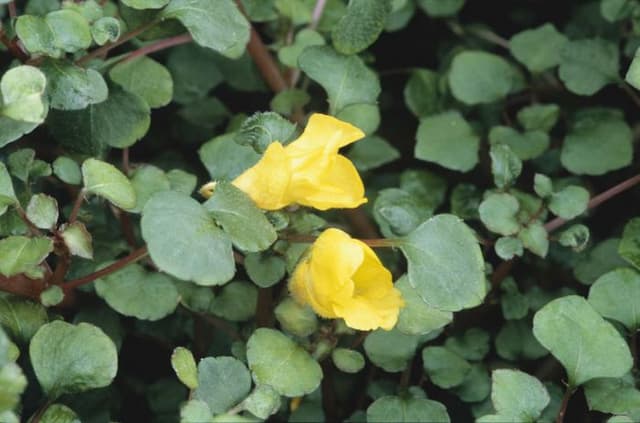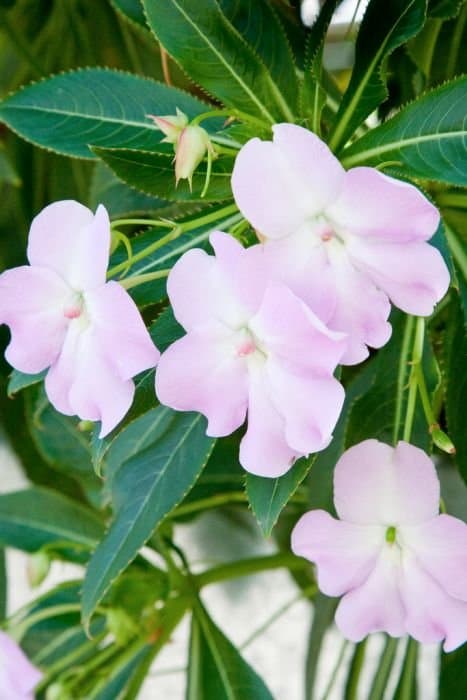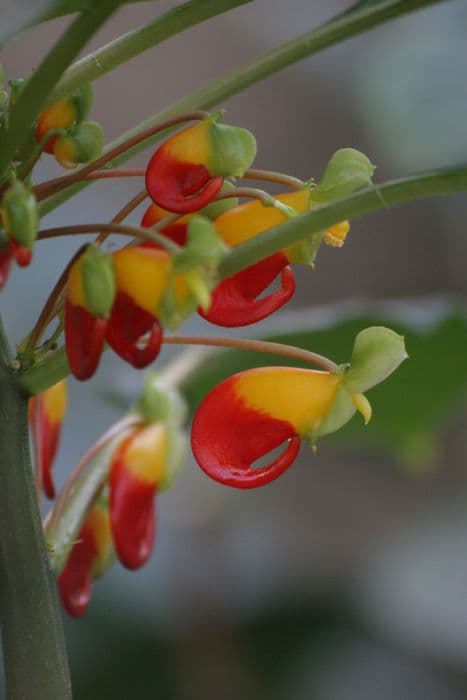Unfortunately, there is no widely recognized common name for Impatiens stenantha specifically. It may generally be referred to by the common name of its genus, which is Impatiens. Impatiens stenantha

ABOUT
Impatiens stenantha, commonly known as the touch-me-not, is characterized by its delicate beauty and distinct floral features. The plant typically bears a lush green foliage, with leaves that have a bright and vibrant tone. The leaves themselves are generally elongated with a pointed tip and can have slightly serrated edges, giving them a fine texture. The touch-me-not is most recognized for its ornate flowers, which are the real showstoppers. The blooms come in a variety of colors, often featuring a pastel palette that can include soft pinks, purples, or even a pale orange hue. The shape of the flowers is intricate, with a distinct, slender spur that extends from the back of the bloom, giving the flower a characteristic profile. The petals are often observed to have a subtle sheen and may display a gentle curvature that enhances the overall delicate appearance of the flower. Another interesting aspect of the touch-me-not's appearance is its seed pods. When touched or disturbed, these pods will burst open, scattering seeds around the immediate area. This feature is where the plant gets its common name, as people are often delighted by the plant's quick response to contact. Overall, the appearance of the touch-me-not is defined by its vibrant leaves and the unique, ornamental beauty of its flowers. The delicate blossoms, combined with the plant's interesting seed dispersal mechanism, make it both enchanting and a favorite among gardeners. Its aesthetic contributes to a variety of garden designs, from cottage gardens to more formal arrangements.
About this plant
 Names
NamesFamily
Balsaminaceae
Synonyms
Impatiens Stenantha
Common names
Impatiens niamniamensis var. stenantha, Impatiens hochstetteri.
 Toxicity
ToxicityTo humans
Information about the toxicity of Impatiens stenantha, commonly known as touch-me-not, to humans is not well-established. However, it is related to other species of Impatiens, which are generally considered non-toxic to humans. Nevertheless, sensitivity can vary, and some individuals might experience mild discomfort or an allergic reaction if parts of the plant are ingested or if they come into contact with the skin. Though toxic reactions are generally rare, ingestion could potentially cause symptoms such as stomach pain, vomiting, or diarrhea in sensitive individuals.
To pets
Impatiens stenantha, also known as touch-me-not, does not have a widespread reputation for being toxic to pets. Most Impatiens species are considered non-toxic to animals, and there is limited information suggesting that Impatiens stenantha is an exception. However, individual pets may have varying sensitivities, and ingestion of the plant could potentially cause mild gastrointestinal upset, including symptoms like nausea, vomiting, or diarrhea. If your pet consumes any part of the plant and you observe any adverse reactions, it is best to consult with a veterinarian.
 Characteristics
CharacteristicsLife cycle
Perennials
Foliage type
Evergreen
Color of leaves
Green
Flower color
Pink
Height
1-2 feet (30-60 cm)
Spread
1-2 feet (30-60 cm)
Plant type
Herb
Hardiness zones
10
Native area
Asia
Benefits
 General Benefits
General Benefits- Aesthetic Value: Impatiens stenantha, commonly known as the Touch-Me-Not, adds visual interest to gardens and landscapes with its delicate flowers and attractive foliage.
- Ease of Care: It is generally easy to grow and maintain, making it an excellent choice for beginner gardeners.
- Pollinator Attraction: The flowers can attract pollinators like bees and butterflies, aiding in the pollination of nearby plants.
- Shade Tolerance: This plant can thrive in shaded areas where other plants might struggle, thus contributing to a diverse shade garden.
- Soil Erosion Control: Impatiens stenantha can help to prevent soil erosion in sloped gardens due to its root system.
- Rapid Growth: It spreads and grows quickly, which can be beneficial for filling in bare spots in a garden relatively fast.
 Medical Properties
Medical PropertiesThis plant is not used for medical purposes.
 Air-purifying Qualities
Air-purifying QualitiesThis plant is not specifically known for air purifying qualities.
 Other Uses
Other Uses- Impatiens stenantha, commonly known as the Snapweed, can be utilized in the creation of dyes for textiles, with different parts of the plant producing varying hues.
- The plant's sap can be investigated for its potential as a natural adhesive in crafting or repair work due to its sticky qualities.
- Incorporate the Snapweed into educational activities for children, showcasing the explosive seed dispersal mechanism to explain plant reproduction.
- Use the Snapweed's unique flower shape as inspiration for artists and designers in various fields such as fashion, jewelry, or homeware design.
- Extract fragrance compounds from the Snapweed flowers for potential use in homemade perfumes, potpourris, or scented candles.
- As a companion plant in gardens, the Snapweed could potentially help to deter certain pests due to its specific characteristics or interplant chemistry.
- The delicate flowers of the Snapweed can be crystallized and used as an ornamental edible garnish in high-end culinary presentations.
- Utilize the Snapweed's distinctive look for thematic gardening, such as in a 'touch-me-not' sensory garden alongside other touch-sensitive plants.
- Study the seed pod's mechanism of dehiscence in the Snapweed to inspire biomimetic designs in engineering and materials science.
- Press and preserve the flowers and leaves of the Snapweed for artistic purposes, such as in creating botanical prints or in resin art.
Interesting Facts
 Feng Shui
Feng ShuiThe Impatiens plant is not used in Feng Shui practice.
 Zodiac Sign Compitability
Zodiac Sign CompitabilityThe Impatiens plant is not used in astrology practice.
 Plant Symbolism
Plant Symbolism- Patience: Impatiens, as the name suggests, symbolizes patience because it is derived from the Latin word 'impatiens', meaning 'impatient'. The plant is so named because its ripe seed pods burst open even at a light touch.
- Inner Reflection: Known for their vibrant blooms and rapid growth, impatiens are also a symbol for inner reflection and the need to explore what truly makes one happy.
- Protective Love: Often given to express a protective form of love, impatiens can represent a relationship where one offers care and understanding without demand.
 Water
WaterImpatiens, commonly known as touch-me-nots or patience plants, appreciate consistently moist soil, so they should be watered regularly. Aim to water them once every 2 to 3 days, more frequently if the weather is particularly hot or dry. The amount of water needed will vary depending on the size of the plant and pot, but as a guideline, use about 16 ounces of water for a standard 6-inch pot each time, ensuring you do not flood the plant. Always check the top inch of soil before watering - if it feels dry to the touch, it's time to water. Avoid letting Impatiens dry out completely as this can stress the plant.
 Light
LightImpatiens thrive best in partial to full shade, making them perfect for brightly shaded spots where direct sunlight is limited. They perform well under the dappled light of trees or on north-facing windowsills where they can get bright but indirect light. Direct sunlight, especially during hot afternoons, can cause leaf scorch and stress the plant.
 Temperature
TemperatureImpatiens prefer temperatures between 60°F and 75°F, which are ideal for their growth and flowering. They can survive at a minimum temperature of around 50°F, but they start to suffer in temperatures below this range. Conversely, temperatures above 85°F can cause the plant to suffer from heat stress.
 Pruning
PruningPruning Impatiens, or patience plants, is beneficial to encourage bushier growth and more blooms. Pinch back the tips of the stems early in the growing season, and remove any dead or yellowing leaves as they appear. The best time for more thorough pruning is in the spring before new growth begins. Pruning can be done every few weeks during the growing season to maintain shape and vigor.
 Cleaning
CleaningAs needed
 Soil
SoilImpatiens, commonly known as touch-me-nots, thrive in well-draining, humus-rich soil with a pH of 6.0 to 7.5. A mix of peat, perlite, and compost is ideal. Adjust the pH using sulfur or lime if necessary.
 Repotting
RepottingTouch-me-nots should generally be repotted every 1-2 years. Since they are fast growers, check annually to decide if repotting is required. Use fresh soil mix when repotting.
 Humidity & Misting
Humidity & MistingTouch-me-nots favor high humidity levels, ideally between 60% to 70%. Avoid placing them in dry environments to maintain optimal growth.
 Suitable locations
Suitable locationsIndoor
Place touch-me-nots in bright, indirect light indoors.
Outdoor
Grow touch-me-nots in shade; avoid direct sunlight.
Hardiness zone
10-11 USDA
 Life cycle
Life cycleImpatiens stenantha, also known as the Narrow-flowered Touch-me-not, begins its life cycle with a seed, typically sprouting in the spring under favorable light, temperature, and moisture conditions. The seed germinates, giving rise to a small seedling that grows and develops its initial set of true leaves. As the seedling matures, it develops a more robust root system and vegetative growth expands with the formation of characteristic green shoots and leaves. The plant then enters the flowering stage, where it produces its distinctive narrow flowers, usually in the summer. Following pollination, these flowers develop into seed capsules that, when mature, burst open upon touch to disperse seeds. The plant completes its life cycle when these seeds fall to the ground, ready to begin the process again in the following growing season, while the parent plant typically withers away with the onset of colder conditions.
 Propogation
PropogationPropogation time
Spring-summer
Impatiens stenantha, commonly known as the Touch-me-not, is typically propagated through seed sowing. The most popular method involves collecting ripe seed pods from the plants, which tend to burst open when touched, hence the common name. Seeds should be sown in late winter or early spring to allow for a full growing season. Sow the seeds thinly onto a tray of moist, well-draining potting mix, and lightly cover them with a thin layer of soil. The tray should be kept at a temperature of around 70 degrees Fahrenheit (21 degrees Celsius), and the soil should be kept moist but not waterlogged. Germination usually occurs within two to three weeks. After the seedlings develop their first true leaves, they can be transplanted into individual pots or into the garden where they will grow into mature plants.
![Busy lizzie [Divine Violet]](/_next/image?url=https%3A%2F%2Fplants-admin.emdemapps.com%2Fimages%2Fplants%2F%2Fimages%2F604b651b90e59.png&w=640&q=75)



![Busy lizzie [SunPatiens Compact Orange]](/_next/image?url=https%3A%2F%2Fplants-admin.emdemapps.com%2Fimages%2Fplants%2F%2Fimages%2F604b5ef883e70.png&w=640&q=75)
![Busy lizzie [SunPatiens Vigorous Magenta]](/_next/image?url=https%3A%2F%2Fplants-admin.emdemapps.com%2Fimages%2Fplants%2F%2Fimages%2F604b622adf631.png&w=640&q=75)


![Busy lizzie [Magnum Wild Salmon]](/_next/image?url=https%3A%2F%2Fplants-admin.emdemapps.com%2Fimages%2Fplants%2F%2Fimages%2F604b589ecbd54.png&w=640&q=75)
